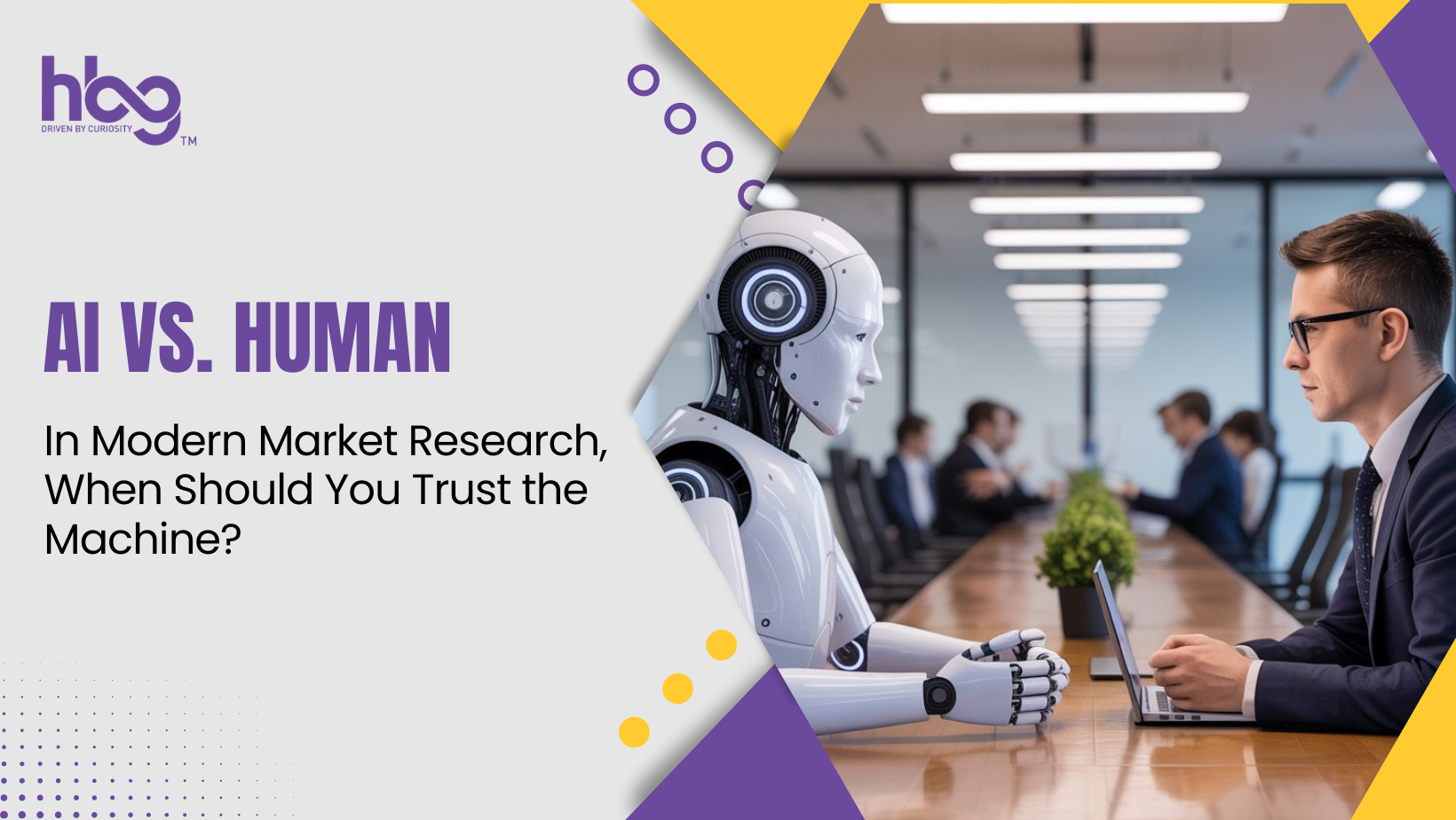
AI vs. Human: In Modern Market Research, When Should You Trust the Machine?
When Data Missed the Craving: The AI vs Human
A rising D2C snack startup launched AI-curated snack boxes, personalized to each customer’s taste. Their algorithm analyzed purchase history, product ratings, and browsing habits to build a monthly selection for each user. But as the campaign unfolded, the AI vs human debate surfaced—could machine-driven personalization truly match the instinctive understanding and emotional nuance of human curation?
At first, it worked well. Customers enjoyed the convenience. But after a few months, subscription cancellations began to rise.
Later, the team found the issue: the AI was great at predicting preferences but failed to understand context, like moods, festivals, personal rituals, or emotional cravings. For instance, one customer said, “I got spicy chips right before Diwali, but I was hoping for something festive and sweet. It just didn’t feel right.”
That’s when the team brought in human insight researchers who conducted interviews, studied customer feedback, and began layering emotional and seasonal context onto the AI’s recommendations.
AI vs. Human: A New Era in Market Research
Market research is evolving rapidly. With the rise of AI and data analytics, what was once a human-led field is now shifting toward a hybrid approach, combining machine efficiency with human insight.
So, where does AI fit in? Can it replace human judgment? And how can researchers get the best of both worlds? This blog explores how AI and human intelligence can work together to unlock deeper, smarter insights in modern research.
How is AI modifying Market Research?
- Efficiency and speed: AI can process massive amounts of data in no time. Tasks that used to take days—like analyzing survey responses or cleaning data—can now be done in minutes. This helps researchers focus on insights rather than manual work, speeding up the entire research process.
- Smarter Business Decisions: With AI-powered insights, companies can make better decisions based on real-time data. AI helps spot patterns in customer behavior, predict trends, and even flag potential risks early. This means businesses can act faster and stay ahead of the competition.
- Automating Data Collection and Analysis: AI can handle repetitive tasks like designing surveys, cleaning messy data, and analyzing results. It can even pick up on patterns or data sources that human researchers might miss. This frees up time for researchers to focus on more strategic and creative work.
- Improved Data Accuracy: AI helps ensure that the data being used is accurate and reliable. It can detect errors, remove fake or misleading responses, and highlight inconsistencies. This means the final insights are based on clean, high-quality data.
- Real-Time, Personalized Interactions: AI can interact with customers through chatbots or voice assistants, making the experience more personal. These natural language conversations help gather valuable insights quickly, while also making customers feel heard and understood.
Why Machines Can’t Replicate Human Storytelling?
- The Power of Storytelling: AI can present facts and data, but only humans can weave them into a story that connects with people emotionally. The way information is delivered matters, and humans have a natural ability to present insights in a relatable and meaningful way.
- Creativity and Thinking Outside the Box: AI works with patterns and existing data, but when it comes to fresh ideas and true innovation, humans lead the way. Human creativity is driven by imagination, intuition, and the ability to think beyond what already exists.
- Emotional Intelligence Matters: AI can mimic emotions, but it doesn’t actually feel them. Humans understand emotions deeply and respond with empathy—something that’s essential in fields like sales, therapy, customer support, and leadership, where emotional connection is key.
- Trust, Privacy, and Human Responsibility: When it comes to handling sensitive or confidential information, people often feel more comfortable trusting a human over a machine. AI systems, being digital, come with risks. That’s why in areas where privacy is critical, human involvement remains essential.
When to Trust AI and When to Trust Humans?
Trust the Machine for:
- Data Collection & Cleaning: Effectively handles large data sets and automates cleaning methods.
- Identifying Trends in Large Datasets: Finds large-scale patterns, relationships, and irregularities that that humans might miss.
- Generating Initial Reports: Creates summaries and dashboards quickly based on raw data.
Trust the Human for:
- Understanding Customer Emotions & Intentions: Understands context, sarcasm, and emotions more accurately than machines.
- Creativity and Innovation: Human creativity is driven by imagination, intuition, and the ability to think beyond what already exists.
- Privacy and Confidentiality: People are trusted to keep sensitive information private and secure.
A Hybrid Approach: The Future of Market Research
Combining the advantages of AI and humans will be essential to the future of market research. While AI brings speed and data-handling power, humans add creativity, emotional understanding, and innovation—creating a well-rounded and powerful research process.
- Unlocking Deeper Insights: By combining AI’s data analysis with human intuition, researchers can discover richer, more meaningful insights that truly reflect real-world behaviors and opinions.
- Saving Time and Reducing Costs: Using both AI and humans helps make the research process faster and more cost-effective. AI takes care of repetitive tasks, so teams spend less time on manual work.
- Boosting Efficiency: AI tools can quickly collect, sort, and analyze data, and even generate reports. This speeds up the entire research cycle and helps deliver results much faster.
- Better Use of Resources: AI can manage large amounts of data and complex reports, freeing up human researchers to focus on high-value tasks like decision-making, storytelling, and strategy.
Finding Flavor in the Hybrid
This story perfectly sums up how the hybrid model worked wonders. Cancellations dropped by 40%, reorders increased, and customers began sharing personalized unboxing stories online, saying things like “It feels like they really get me now.”
AI offers speed, scale, and efficiency—but it can miss the emotional connection. Humans, on the other hand, bring in empathy, context, and creativity. By blending both, the startup didn’t just fix a retention problem—they created a deeply personal, emotionally intelligent customer experience.
Final Thoughts
AI and humans aren’t competitors—they’re teammates. When machines provide speed and scale, and humans offer creativity and empathy, market research becomes more powerful, more accurate, and more impactful. The real magic happens when you trust both.
Author
Tanu Gautam
Experienced AVP operations with over 13 years of comprehensive expertise in market research. Proven track record in leading high-performing teams, defining strategic research methodologies and delivering actionable insights to drive business growth. Proficient at leveraging innovative technologies and methodologies to optimize research process and enhance data-driven decision-making. Passionate about uncovering market trends and consumer behavior to inform strategic business initiatives.
